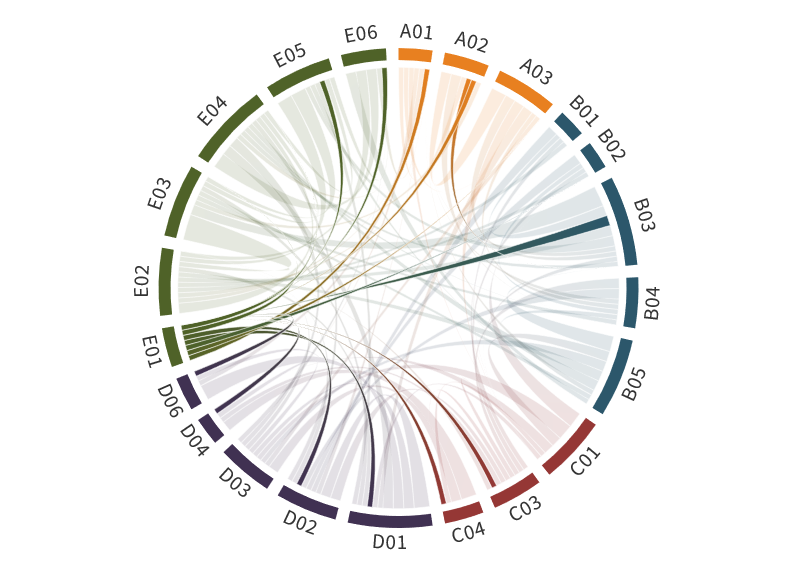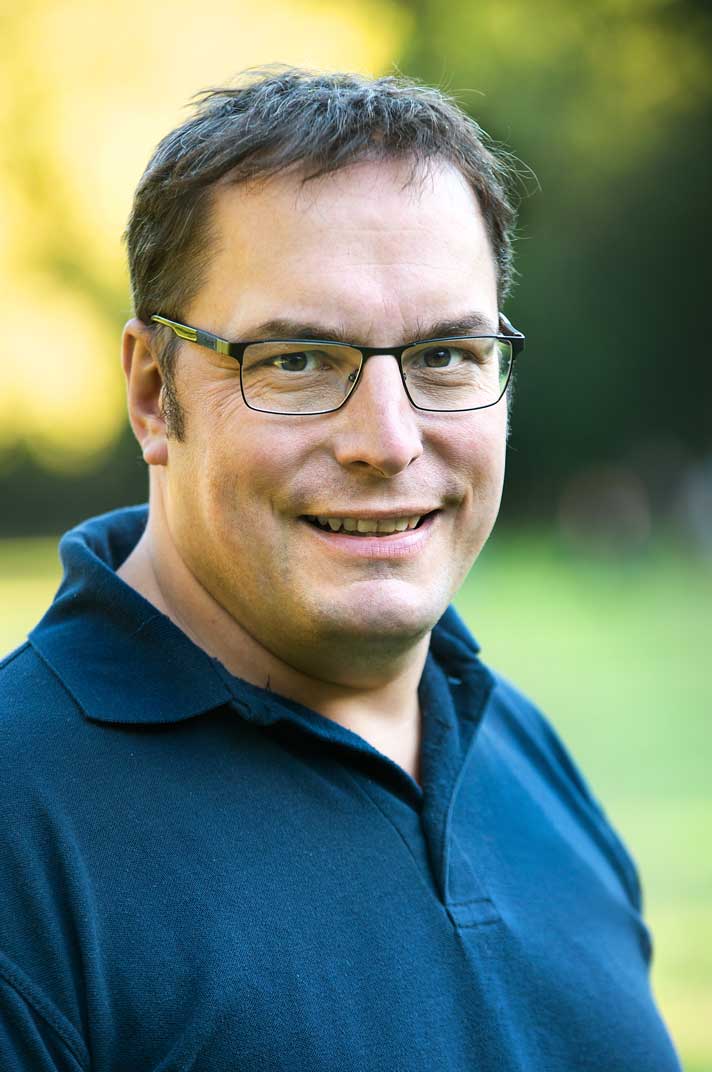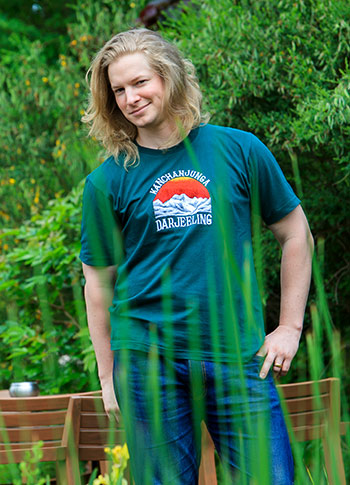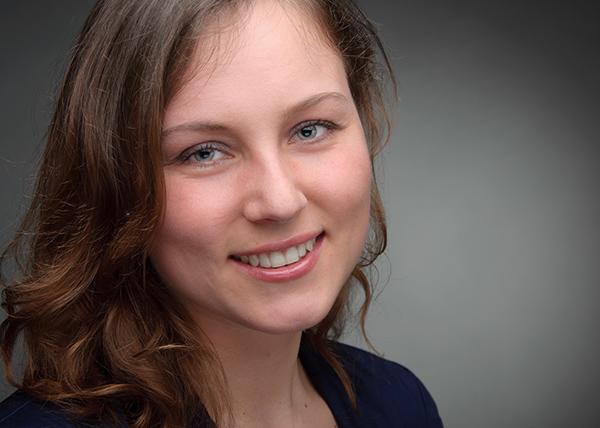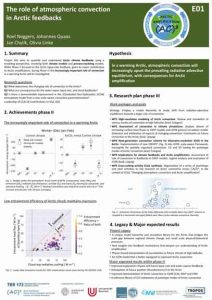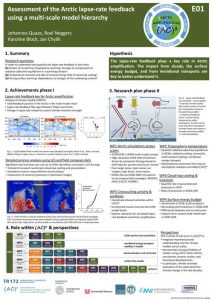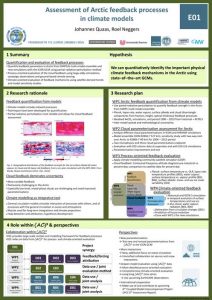E01: The role of atmospheric convection in Arctic feedbacks
PIs: Roel Neggers, Johannes Quaas
Project E01 aims to quantify and understand Arctic climate feedbacks using a modeling perspective. This started in phase I with a quantification of feedbacks from climate models and a process-oriented focus on the cloud feedback. On the basis of the results, we selected the Arctic lapse-rate feedback (LRF) as the one that stands out, besides the surface albedo feedback, as cause for Arctic amplification, for particular scrutiny in phase II. A key result of phase II was that the Arctic energy budget within the atmosphere, that used to be dominated by a radiative-advective equilibrium, at least occasionally, but increasingly, is moving towards the radiative-convective equilibrium that determines Tropical lapserates. More precisely, the radiative cooling of the atmosphere is increasingly balanced by the surface sensible and latent heat fluxes (the latter measurable as precipitation), driven by shallow as well as deeper convection. This leads to the scientific focus of E01 in phase III on convection. Essential climate feedbacks are related to atmospheric convection, including most notably the water vapor and LRF, but also cloud feedback mechanisms.
This topic will be addressed by synergistic exploitation of models: high-resolution convection-resolving simulations for representative cases; assessment of changing convection mechanisms in available climate simulations, reanalysis and satellite retrievals; joint improvement of kilometer-scale ICON using novel convective parameterizations; and investigation of implications for feedbacks and future Arctic climate change.
Hypothesis:
In a warming Arctic, atmospheric convection will increasingly upset the prevailing radiative-advective equilibrium, with consequences for Arctic amplification.
Specifically, E01 will answer the questions:
- What determines the changing role of convection in the Arctic?
- What are consequences for the water vapor, lapse rate, and cloud feedbacks?
- Is there a demonstrable improvement in the ICOsahdral Non-hydrostatic (ICON) atmosphere model from a new scale-aware convection parameterization?
E01 mostly links to SQ1, by assessing the role changing convection for Arctic climate feedbacks. It also constrains models and thus links to SQ2 .
Achievements phase I
E01 has shown, that the total feedback in the Arctic in many global circulation models leads to a local runaway climate, due to the surface albedo and lapse rate feedback mechanisms (Block et al., 2020). The lapse rate feedback is strongest in boreal winter over sea ice and land, and is related to the temperature inversion strength (Lauer et al., 2019). Furthermore, the ICON modelling system has been thoroughly tested against observations in the Arctic (Neggers et al., 2019), and is ready for use in studies of feedback mechanisms in Arctic climate during phase II.
Role within (AC)³
Members
Prof. Dr. Johannes Quaas
Principal Investigator
University of Leipzig
Leipzig Institute for Meteorology (LIM)
Stephanstr. 3
04103 Leipzig
Olivia Linke
PhD
University of Leipzig
Leipzig Institute for Meteorology (LIM)
Stephanstr. 3
04103 Leipzig
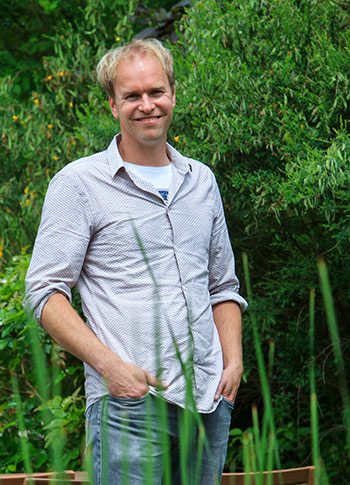
Prof. Dr. Roel Neggers
Principal Investigator
University of Cologne
Institute for Geophysics and Meteorology (IGM)
Pohligstr. 3
50969 Cologne
Dr. Jan Chylík
Postdoc
University of Cologne
Institute for Geophysics and Meteorology (IGM)
Pohligstr. 3
50969 Cologne
Former Members
Dr. Tom Goren
Postdoc
University of Leipzig
Leipzig Institute for Meteorology (LIM)
Stephanstr. 3
04103 Leipzig
Karoline Block
Postdoc
University of Leipzig
Leipzig Institute for Meteorology (LIM)
Stephanstr. 3
04103 Leipzig
Publications
2024
2023
Linke, O., Feldl, N. and Quaas, J., 2023: Current-climate sea ice amount and seasonality as constraints for future Arctic amplification. Environ. Res. Clim., 2(4), p.045003., DOI 10.1088/2752-5295/acf4b7
Wendisch, M.; Brückner, M.; Crewell, S.; Ehrlich, A.; Notholt, J.; Lüpkes, C.; Macke, A.; Burrows, J. P.; Rinke, A.; Quaas, J.; Maturilli, M.; Schemann, V.; Shupe, M. D.; Akansu, E. F.; Barrientos-Velasco, C.; Bärfuss, K.; Blechschmidt, A.-M.; Block, K.; Bougoudis, I.; Bozem, H.; Böckmann, C.; Bracher, A.; Bresson, H.; Bretschneider, L.; Buschmann, M.; Chechin, D. G.; Chylik, J.; Dahlke, S.; Deneke, H.; Dethloff, K.; Donth, T.; Dorn, W.; Dupuy, R.; Ebell, K.; Egerer, U.; Engelmann, R.; Eppers, O.; Gerdes, R.; Gierens, R.; Gorodetskaya, I. V.; Gottschalk, M.; Griesche, H.; Gryanik, V. M.; Handorf, D.; Harm-Altstädter, B.; Hartmann, J.; Hartmann, M.; Heinold, B.; Herber, A.; Herrmann, H.; Heygster, G.; Höschel, I.; Hofmann, Z.; Hölemann, J.; Hünerbein, A.; Jafariserajehlou, S.; Jäkel, E.; Jacobi, C.; Janout, M.; Jansen, F.; Jourdan, O.; Jurányi, Z.; Kalesse-Los, H.; Kanzow, T.; Käthner, R.; Kliesch, L. L.; Klingebiel, M.; Knudsen, E. M.; Kovács, T.; Körtke, W.; Krampe, D.; Kretzschmar, J.; Kreyling, D.; Kulla, B.; Kunkel, D.; Lampert, A.; Lauer, M.; Lelli, L.; von Lerber, A.; Linke, O.; Löhnert, U.; Lonardi, M.; Losa, S. N.; Losch, M.; Maahn, M.; Mech, M.; Mei, L.; Mertes, S.; Metzner, E.; Mewes, D.; Michaelis, J.; Mioche, G.; Moser, M.; Nakoudi, K.; Neggers, R.; Neuber, R.; Nomokonova, T.; Oelker, J.; Papakonstantinou-Presvelou, I.; Pätzold, F.; Pefanis, V.; Pohl, C.; van Pinxteren, M.; Radovan, A.; Rhein, M.; Rex, M.; Richter, A.; Risse, N.; Ritter, C.; Rostosky, P.; Rozanov, V. V.; Donoso, E. R.; Saavedra-Garfias, P.; Salzmann, M.; Schacht, J.; Schäfer, M.; Schneider, J.; Schnierstein, N.; Seifert, P.; Seo, S.; Siebert, H.; Soppa, M. A.; Spreen, G.; Stachlewska, I. S.; Stapf, J.; Stratmann, F.; Tegen, I.; Viceto, C.; Voigt, C.; Vountas, M.; Walbröl, A.; Walter, M.; Wehner, B.; Wex, H.; Willmes, S.; Zanatta, M. & Zeppenfeld, S., 2023: Atmospheric and Surface Processes, and Feedback Mechanisms Determining Arctic Amplification: A Review of First Results and Prospects of the (AC)³ Project, Bull. Am. Meteorol. Soc., American Meteorological Society, 104, E208–E242, https://doi.org/10.1175/bams-d-21-0218.1
Linke, O., Quaas, J., Baumer, F., Becker, S., Chylik, J., Dahlke, S., Ehrlich, A., Handorf, D., Jacobi, C., Kalesse-Los, H., Lelli, L., Mehrdad, S., Neggers, R. A. J., Riebold, J., Saavedra Garfias, P., Schnierstein, N., Shupe, M. D., Smith, C., Spreen, G., Verneuil, B., Vinjamuri, K. S., Vountas, M., and Wendisch, M., 2023: Constraints on simulated past Arctic amplification and lapse rate feedback from observations, Atmos. Chem. Phys., 23, 9963–9992, https://doi.org/10.5194/acp-23-9963-2023.
Chylik, J., Chechin, D., Dupuy, R., Kulla, B. S., Lüpkes, C., Mertes, S., Mech, M., and Neggers, R. A. J., 2023: Aerosol impacts on the entrainment efficiency of Arctic mixed-phase convection in a simulated air mass over open water, Atmos. Chem. Phys., https://doi.org/10.5194/acp-23-4903-2023.
2022
Linke, O. and Quaas, J., 2022. The Impact of CO2-Driven Climate Change on the Arctic Atmospheric Energy Budget in CMIP6 Climate Model Simulations. Tellus A: Dyn. Meteorol. Oceanogr., 74(2022), pp.106–118. http://doi.org/10.16993/tellusa.29
Geerts, B.; Giangrande, S. E.; McFarquhar, G. M.; Xue, L.; Abel, S. J.; Comstock, J. M.; Crewell, S.; DeMott, P. J.; Ebell, K.; Field, P.; Hill, T. C. J.; Hunzinger, A.; Jensen, M. P.; Johnson, K. L.; Juliano, T. W.; Kollias, P.; Kosovic, B.; Lackner, C.; Luke, E.; Lüpkes, C.; Matthews, A. A.; Neggers, R.; Ovchinnikov, M.; Powers, H.; Shupe, M. D.; Spengler, T.; Swanson, B. E.; Tjernström, M.; Theisen, A. K.; Wales, N. A.; Wang, Y.; Wendisch, M. & Wu, P., 2022: The COMBLE Campaign: A Study of Marine Boundary Layer Clouds in Arctic Cold-Air Outbreaks, Bull. Am. Meteorol. Soc., 103, E1371 – E1389, https://doi.org/10.1175/BAMS-D-21-0044.1
2021
2020
Lauer, M., K. Block, M. Salzmann, and J. Quaas, 2020: CO2-forced changes of Arctic temperature lapse-rates in CMIP5 models, Meteorolog. Zeitschrift, vol. 29, no. 1, pp. 79–93, doi: 10.1127/metz/2020/0975
Block, K., F.A. Schneider, J. Mülmenstädt, M. Salzmann, and J. Quaas, 2020: Climate models disagree on the sign of total radiative feedback in the Arctic, Tellus A: Dynamic Meteorology and Oceanography, 72:1, 1-14, doi:10.1080/16000870.2019.1696139
2019
Goren, T., J. Kazil, F. Hoffmann, T. Yamaguchi, and G. Feingold, 2019: Anthropogenic Air Pollution Delays Marine Stratocumulus Break‐up to Open‐Cells, Geophys. Res. Lett., https://doi.org/10.1029/2019GL085412
Wendisch, M., A. Macke, A. Ehrlich, C. Lüpkes, M. Mech, D. Chechin, K. Dethloff, C. Barrientos, H. Bozem, M. Brückner, H.-C. Clemen, S. Crewell, T. Donth, R. Dupuy, C. Dusny, K. Ebell, U. Egerer, R. Engelmann, C. Engler, O. Eppers, M. Gehrmann, X. Gong, M. Gottschalk, C. Gourbeyre, H. Griesche, J. Hartmann, M. Hartmann, B. Heinold, A. Herber, H. Herrmann, G. Heygster, P. Hoor, S. Jafariserajehlou, E. Jäkel, E. Järvinen, O. Jourdan, U. Kästner, S. Kecorius, E.M. Knudsen, F. Köllner, J. Kretzschmar, L. Lelli, D. Leroy, M. Maturilli, L. Mei, S. Mertes, G. Mioche, R. Neuber, M. Nicolaus, T. Nomokonova, J. Notholt, M. Palm, M. van Pinxteren, J. Quaas, P. Richter, E. Ruiz-Donoso, M. Schäfer, K. Schmieder, M. Schnaiter, J. Schneider, A. Schwarzenböck, P. Seifert, M.D. Shupe, H. Siebert, G. Spreen, J. Stapf, F. Stratmann, T. Vogl, A. Welti, H. Wex, A. Wiedensohler, M. Zanatta, S. Zeppenfeld, 2019: The Arctic Cloud Puzzle: Using ACLOUD/PASCAL Multi-Platform Observations to Unravel the Role of Clouds and Aerosol Particles in Arctic Amplification, Bull. Amer. Meteor. Soc., 100 (5), 841–871, doi:10.1175/BAMS-D-18-0072.1
Roode, S.R., T. Frederikse, A.P. Siebesma, A.S. Ackerman, J. Chylik, P.R. Field, J. Fricke, M. Gryschka, A. Hill, 2019: Turbulent transport in the gray zone: A large eddy model intercomparison study of the CONSTRAIN cold air outbreak case, Journal of Advances in Modeling Earth Systems, 11, 597– 623, doi:10.1029/2018MS001443
2018
Pithan, F., G. Svensson, R. Caballero, D. Chechin, T.W. Cronin, A.M.L. Ekman, R. Neggers, M.D. Shupe, A. Solomon, M. Tjernström, and M. Wendisch, 2018: Role of air-mass transformations in exchange between the Arctic and mid-latitudes, Nature Geoscience, doi:10.1038/s41561-018-0234-1
Block, C., 2018: Aerosol-Cloud-Radiation interactions in regimes of liquid water clouds, PhD Thesis, University of Leipzig, https://nbn-resolving.org/urn:nbn:de:bsz:15-qucosa2-319314
Salzmann, M., 2017: The polar amplification asymmetry: Role of antarctic surface height, Earth Syst. Dynam., 8, 323-336, doi:10.5194/esd-8-323-2017

